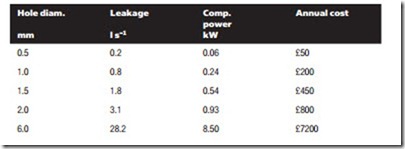cost of air leaks
Air leaks from a compressed air system are very noisy and may even be hazardous to health. They are also surprisingly expensive. The table below shows the required compressor power and the corresponding annual costs of various sizes of leaks. It is assumed that the air is at a standard 7 bar in a factory which runs 24 hours a day for 50 weeks a year and pays 10 p per kW h for their electricity.
Note that the cost rises as the square of the diameter of the leakage hole; twice the diameter gives four times the cost. Fortunately the noise makes leaks relatively easy to find.
silencers
When a cylinder or other actuator moves at high speed air has to be quickly re- moved from the non-pressurized port of the actuator. This air invariably vents to atmosphere. When the cylinder is large or the speed of motion is fast the exhaust
air exits at high speed with a pistol-like crack. This noise is very intrusive and can even be of a level which can cause hearing damage.
One solution is to put flow restrictors in the exhaust line to reduce the velocity and extend the time over which the air blast takes place. Alternatively, specially designed silencers can be fitted to the actuator or valve. These are generally constructed as a porous mesh through which the air loses velocity and exhausts over a wide area, reducing the force and the noise. Often a silencer has a built-in adjustable flow restrictor.
A related device is an exhaust filter/silencer (also known as a reclassifier), which is used when the exhausting air has a significant oil content. The silencer incorporates a filter which captures the oil in the air to reduce airborne contamination. The captured oil runs down into a sump which must be manually drained at regular intervals.
Symbols for a silencer and filter/silencer are shown in Figure 6.14.

